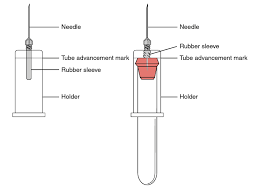Which of the following should be collected first for tests including CBC, chemistry panel, lead, and a toxicology screen via capillary puncture?
Red top tube
Lavender top tube
Light blue top tube
Royal blue top tube
The Correct Answer is B
Choice A Reason:
The red top tube is typically used for serum determinations in chemistry, serology, and blood bank. It contains no additive or may contain a clot activator. The red top tube is not the first choice for capillary puncture order of draw because it is designed for tests that require serum and not whole blood.
Choice B Reason:
The lavender top tube is used for whole blood hematology determinations, as it contains EDTA as an anticoagulant. According to the order of draw for capillary punctures, the EDTA tube should be collected first to ensure adequate volume and accurate hematology test results. This makes the lavender top tube the correct choice for the first collection in this scenario.
Choice C Reason:
The light blue top tube contains sodium citrate and is used for coagulation tests. In venipuncture, it is drawn after the blood culture bottle and before other tubes to prevent contamination with additives from other tubes. However, for capillary punctures, it is not the first choice as hematology tests take precedence.
Choice D Reason:
The royal blue top tube is used for trace element, toxicology, and nutrient determinations². While it may be used for lead and toxicology screens mentioned in the question, it is not the first tube to be drawn in a capillary puncture sequence. The EDTA tube (lavender top) is drawn first to prevent clotting and ensure accurate CBC results.
Nursing Test Bank
Naxlex Comprehensive Predictor Exams
Related Questions
Correct Answer is C
Explanation
Choice A Reason:
Povidone-iodine is an antiseptic used for skin disinfection before and after surgery. It has a broad spectrum of antimicrobial activity, but it is not the preferred choice for capillary blood collection due to the potential interference with certain laboratory tests. Povidone-iodine needs to be completely dried to avoid hemolysis of the sample, which can affect test results.
Choice B Reason:
Hand sanitizer is generally used for hand hygiene and not for the disinfection of the site for blood specimen collection. While it is effective in killing germs on the skin, it contains emollients and gelling agents that can contaminate the blood sample and interfere with laboratory tests.
Choice C Reason:
70% isopropyl alcohol is the most commonly used disinfectant for aseptic technique in capillary blood collection. It is effective against a broad range of microorganisms and evaporates quickly, leaving no residue that could contaminate the sample. It is important to allow the alcohol to dry completely before performing the puncture to prevent stinging and sample dilution.
Choice D Reason:
A 10% chlorine bleach solution is not typically used for skin disinfection in blood collection due to its harshness and potential to cause skin irritation and damage. It is more commonly used for disinfecting surfaces and equipment in healthcare settings.
Correct Answer is A
Explanation
Choice A Reason:
The evacuated tube system is designed for the collection of multiple blood specimens using interchangeable tubes. This system utilizes a double-pointed needle, one end of which goes into the patient's vein and the other into a vacuum tube. As the blood is drawn, it automatically fills the tube until the vacuum is exhausted. The phlebotomist can then easily replace the filled tube with another without removing the needle from the patient's vein, allowing for multiple samples to be taken during a single venipuncture.
Choice B Reason:
The hypodermic needle and syringe system is typically used for manual blood draws when the evacuated tube system is not suitable, such as with small or fragile veins. This system does not use interchangeable tubes; instead, the blood is drawn into a syringe and then transferred into the appropriate tubes, which can be time-consuming and increase the risk of hemolysis or contamination.
Choice C Reason:
A winged infusion set, also known as a butterfly needle, is often used for patients with difficult veins. Like the hypodermic needle and syringe system, it does not inherently allow for the use of interchangeable multi-sample tubes. Blood is collected into a syringe or a single tube attached to the butterfly needle, and changing tubes usually requires a new puncture for each sample.
Choice D Reason:
The lancet microcollection system is used for capillary blood collection, typically from a fingerstick or heelstick. It is used for small volume samples and does not accommodate interchangeable multi-sample tubes. This method is commonly used for pediatric patients or when only a small amount of blood is needed.

Whether you are a student looking to ace your exams or a practicing nurse seeking to enhance your expertise , our nursing education contents will empower you with the confidence and competence to make a difference in the lives of patients and become a respected leader in the healthcare field.
Visit Naxlex, invest in your future and unlock endless possibilities with our unparalleled nursing education contents today
Report Wrong Answer on the Current Question
Do you disagree with the answer? If yes, what is your expected answer? Explain.
Kindly be descriptive with the issue you are facing.
